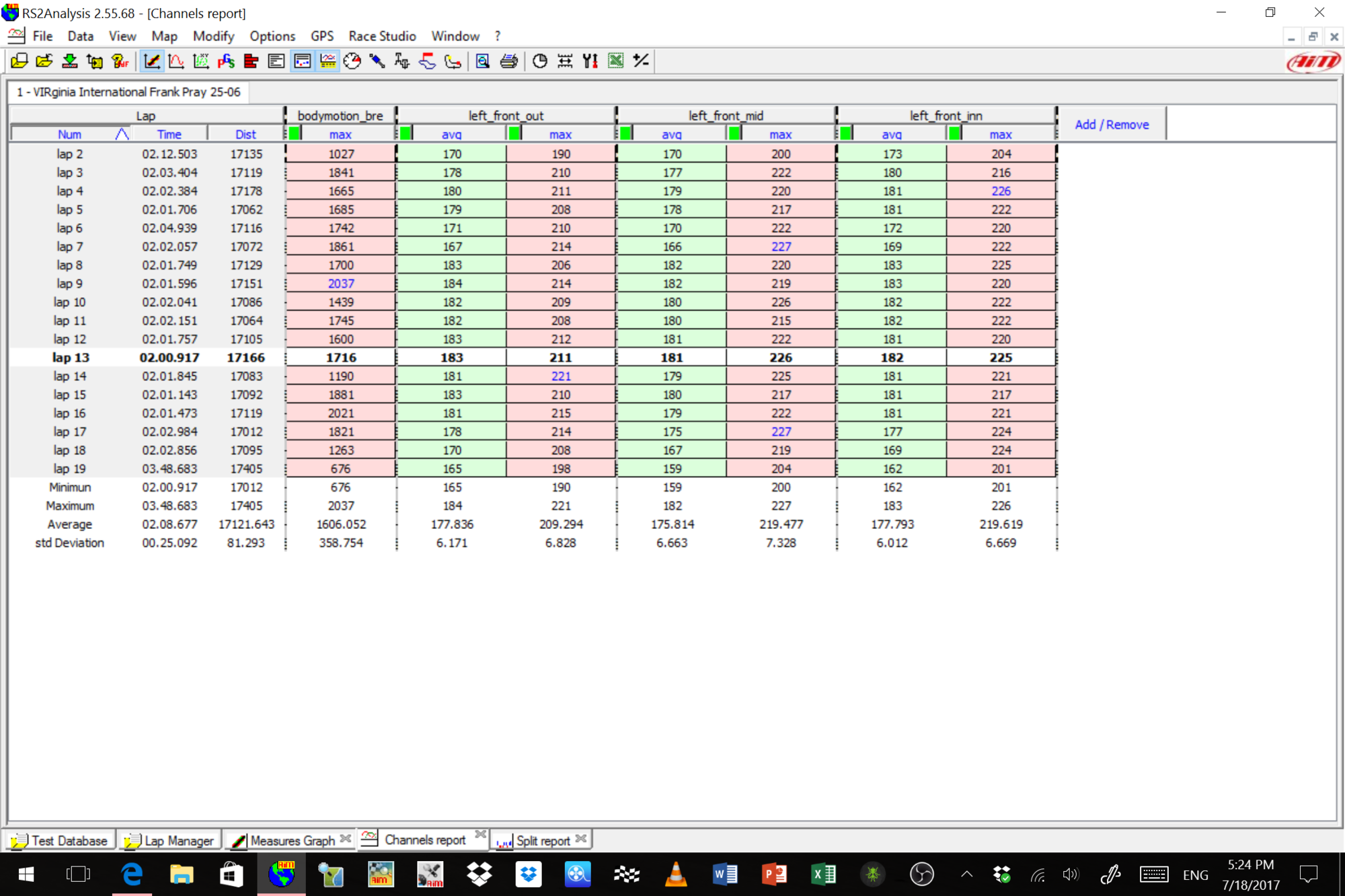AiM $100 IR Tire Temps! For Sale now!
#46
Addict
Rennlist Member
Rennlist Member
These are two laps from the Enduro race on this graph (front left tire only - three sensors across the tire):
1) An average lap during the session (ORANGE)
2) My cool down lap coming into the pits at the end of the race (BLUE)
- Top Graph is speed, followed by the left tire (outer, mid, inner)
- Bottom Graph shows per lap statistics (Average, Max) for each sensor
Key takeaways:
- The temperature gradient driving through the pits is about half in comparison to the same location out on track during the average lap
- This is a good way to measure peak temps on the track and make sure you are under the 250 deg F max given by Pirelli
- For set up, we use lap average temperature or the lap integral temperatures
Ambient temp was 84 deg. Track surface temp was approx. 110 deg.


#47
Rennlist
Basic Site Sponsor
Basic Site Sponsor
Join Date: Jun 2008
Location: Durham, NC and Virginia International Raceway
Posts: 18,996
Received 3,114 Likes
on
1,812 Posts
Great stuff, Frank! Thanks for sharing.
#49
Rennlist Hoonigan
which cost no drachmas
Lifetime Rennlist
Member
Rennlist
Site Sponsor
which cost no drachmas
Lifetime Rennlist
Member
Rennlist
Site Sponsor
Thread Starter
Mid corner they should be even if the tires are flat to the track with suspension compression and body roll. The hot inside comes from the extra camber during straights. I'll try and post some data showing this tomorrow.
#50
Rennlist
Basic Site Sponsor
Basic Site Sponsor
Join Date: Jun 2008
Location: Durham, NC and Virginia International Raceway
Posts: 18,996
Received 3,114 Likes
on
1,812 Posts
On open wheel cars, yes, even temps under load.
__________________
-Peter Krause
www.peterkrause.net
www.gofasternow.com
"Combining the Art and Science of Driving Fast!"
Specializing in Professional, Private Driver Performance Evaluation and Optimization
Consultation Available Remotely and at VIRginia International Raceway
-Peter Krause
www.peterkrause.net
www.gofasternow.com
"Combining the Art and Science of Driving Fast!"
Specializing in Professional, Private Driver Performance Evaluation and Optimization
Consultation Available Remotely and at VIRginia International Raceway
#51
Rennlist Hoonigan
which cost no drachmas
Lifetime Rennlist
Member
Rennlist
Site Sponsor
which cost no drachmas
Lifetime Rennlist
Member
Rennlist
Site Sponsor
Thread Starter
Here are a couple of screen shots from my data last weekend at the Glen. The first is the full lap and you can see on the rear tires with 3 sensors each how the tire temps are not even on the straights. I'm running around -2.25* of camber in the rear. This places more load on the inside edge and drives the temps higher.
The second image is zoomed into turn 6, a right hand corner. If you look at the fourth graph down, you'll see when on the straight leading to it, there is about a 30* difference from inside to outside. Once in the corner with body roll and chassis compression it's 5.9*.
Air flow is the not the prime driver of tire temp.
The second image is zoomed into turn 6, a right hand corner. If you look at the fourth graph down, you'll see when on the straight leading to it, there is about a 30* difference from inside to outside. Once in the corner with body roll and chassis compression it's 5.9*.
Air flow is the not the prime driver of tire temp.
#52
Rennlist
Basic Site Sponsor
Basic Site Sponsor
Join Date: Jun 2008
Location: Durham, NC and Virginia International Raceway
Posts: 18,996
Received 3,114 Likes
on
1,812 Posts
As you point out, it's the loading that is the primary determinant of temps. As I said, most tire engineers state that an even temp spread is not the optimum measure of equalized load, more about the distortion of the tread as it's presented to the road under that period of maximum loading.
Your observed spread matched the maximum spread I've been told is optimal.
Your observed spread matched the maximum spread I've been told is optimal.
#53
Rennlist Hoonigan
which cost no drachmas
Lifetime Rennlist
Member
Rennlist
Site Sponsor
which cost no drachmas
Lifetime Rennlist
Member
Rennlist
Site Sponsor
Thread Starter
As I said, most tire engineers state that an even temp spread is not the optimum measure of equalized load, more about the distortion of the tread as it's presented to the road under that period of maximum loading.
Your observed spread matched the maximum spread I've been told is optimal.
Your observed spread matched the maximum spread I've been told is optimal.
On pit road, with a probe, you should see a less than 30*, preferably 20*F or less spread. This has been confirmed to me by tire engineers at multiple companies, including the people that actually design the tires run by people here.
When looking at IR temps, when the car has compressed the suspension and rolled, you want an even temp across the tire. This is the time when the tire is working the most and in "full" contact with the road. The temps down the straights will vary because the static camber settings do not present a full tire to the road.
As a side note, for many companies, what they put in the literature versus what they engineers really want do not always match. The 30* spread is not what they really want but is acceptable. In my experience, they all want a 10-20*F spread on pit road (assuming a hot entry).
If you're understanding is different, maybe you have some data you can share to illustrate it?

